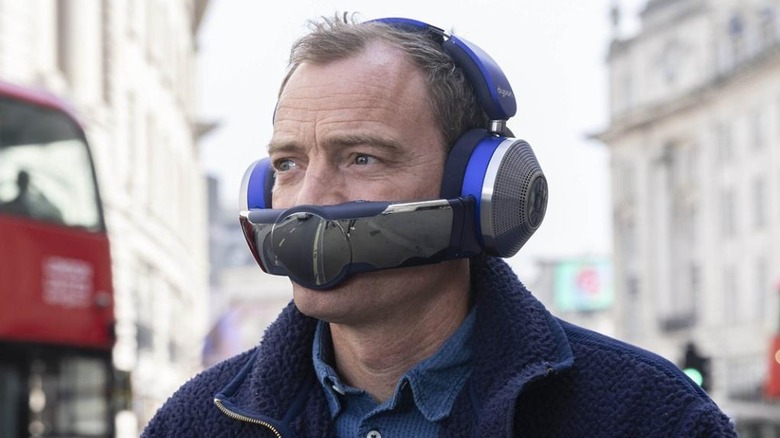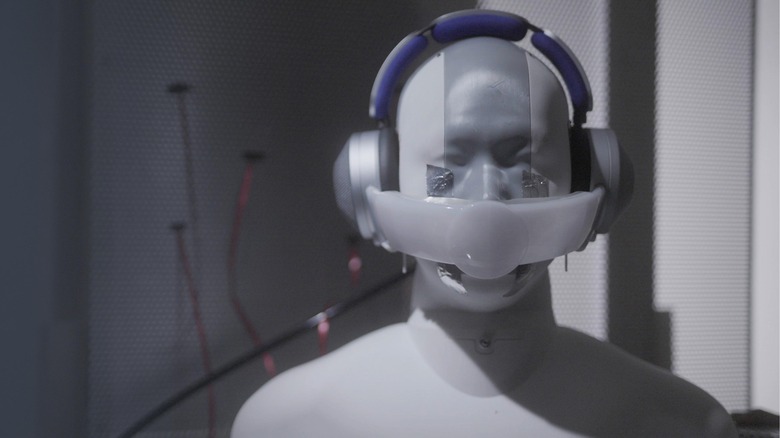Dyson Zone Air-Purifying Headphones: Here's How It Works
Have you ever wanted to own a pair of headphones that also covers your nose and mouth for air-filtering purposes? No? Well, Dyson probably thinks many people do want such a device — because why else would it make the Dyson Zone pollution mask? The Zone is a personal face mask/air purifier/noise-canceling headphones combo, and although it may look like an oddity, the company seems convinced it's exactly what the current market needs. In fact, Dyson just announced the product's upcoming release.
Looking at the Dyson Zone, you'd think it must be a byproduct of the ongoing COVID-19 pandemic. After all, the West was blissfully unaware of the number of bad things in the air before, and as such, face masks were rarely worn outside of operating rooms and job sites. However, the Dyson Zone arrives after 6 years of trial-and-error and a total of approximately 500 prototypes. Invented by Jake Dyson, son of James Dyson and chief engineer on this project, the Zone seems to have the tech to back up its usefulness. But let's not kid ourselves — it looks peculiar at best.
If you've ever wanted to resemble the character of Bane from "The Dark Knight Rises," Dyson Zone makes for a great, if expensive, cosplay idea. It also marks Dyson's first attempt at creating a wearable air purifier.
ANC headphones and clean air in one odd device
How exactly does this strange contraption work? The Dyson Zone is a head-mounted air purifier. The plastic piece that covers the user's mouth and nose connects directly to a set of active noise-canceling (ANC) headphones. Each earphone comes with a miniature fan that gathers the air around you, sends it on a journey through a series of filters, and then expels it fully filtered directly over your face. Up to 99% of the air that Dyson Zone takes in is filtered, and particles as small as 0.1 microns, including pollen, dust, and bacteria, are all cleaned away before the air reaches your mouth and nose.
The connection between the mouth visor and the earphones is even more pronounced than described above. Both headphones come with sensors that adjust airflow levels based on how fast you're moving. Considering every head is different, both the headphones and the visor have size-adjustable parts. Dyson also developed an additional attachment that comes with an FFP2 filter and serves as a face mask replacement, but we assume that will be sold extra.
If you happen to be in an area with better air quality, you can detach the freaky-looking visor and simply use the headphones. Speaking of the headphones — they can be used just like any ANC cans for calls, music, podcasts, and the like. However, the sound quality is unlikely to sweep you off your feet, as the main feature of the headphones is to offer good noise-canceling in order to block out the constant sound of the fans.
Air pollution is a problem, but Dyson Zone may not be the answer
According to the World Health Organization (WHO), nine out of 10 people all over the world breathe air that has unacceptably high levels of pollution. The risk of catching COVID-19 is just one small part of a larger puzzle composed of a number of dangerous pollutants that damage our respiratory systems over time. As such, it makes perfect sense to want to breathe cleaner air even when outside, but there is already some controversy about the Dyson Zone.
Naomi Wu, a YouTuber, brings up some good examples of why the technology could be potentially controversial at a time when there's a pandemic going on. Considering the novel coronavirus spreads very rapidly, wearing a device such as this is risky — not for the wearer, but for those around them. After all, the air goes both ways, and while the user gets it when it's clean and filtered, the device also expels air, potentially helping in virus transmission. Dyson is yet to respond to these controversies.
Another possible issue with the Dyson Zone is that it likely will cost a small fortune. The company hasn't talked about pricing as of yet, but if you were hoping to pick up a pair for less than a few hundred dollars, you may end up disappointed. Of course, we won't find out for sure until the company comments on the pricing. For now, all we can do is wait for the release date, which is expected to happen sometime in the fall of 2022.


